Regulation of differentiation by HBP1, a target of the retinoblastoma protein
- PMID: 9671483
- PMCID: PMC109059
- DOI: 10.1128/MCB.18.8.4732
Regulation of differentiation by HBP1, a target of the retinoblastoma protein
Abstract
Differentiation is a coordinated process of irreversible cell cycle exit and tissue-specific gene expression. To probe the functions of the retinoblastoma protein (RB) family in cell differentiation, we isolated HBP1 as a specific target of RB and p130. Our previous work showed that HBP1 was a transcriptional repressor and a cell cycle inhibitor. The induction of HBP1, RB, and p130 upon differentiation in the muscle C2C12 cells suggested a coordinated role. Here we report that the expression of HBP1 unexpectedly blocked muscle cell differentiation without interfering with cell cycle exit. Moreover, the expression of MyoD and myogenin, but not Myf5, was inhibited in HBP1-expressing cells. HBP1 inhibited transcriptional activation by the MyoD family members. The inhibition of MyoD family function by HBP1 required binding to RB and/or p130. Since Myf5 might function upstream of MyoD, our data suggested that HBP1 probably blocked differentiation by disrupting Myf5 function, thus preventing expression of MyoD and myogenin. Consistent with this, the expression of each MyoD family member could reverse the inhibition of differentiation by HBP1. Further investigation implicated the relative ratio of RB to HBP1 as a determinant of whether cell cycle exit or full differentiation occurred. At a low RB/HBP1 ratio cell cycle exit occurred but there was no tissue-specific gene expression. At elevated RB/HBP1 ratios full differentiation occurred. Similar changes in the RB/HBP1 ratio have been observed in normal C2 differentiation. Thus, we postulate that the relative ratio of RB to HBP1 may be one signal for activation of the MyoD family. We propose a model in which a checkpoint of positive and negative regulation may coordinate cell cycle exit with MyoD family activation to give fidelity and progression in differentiation.
Figures


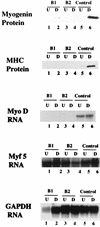
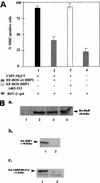


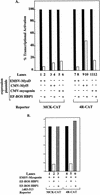
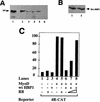
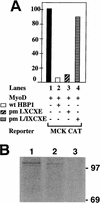

Similar articles
-
HBP1: a HMG box transcriptional repressor that is targeted by the retinoblastoma family.Genes Dev. 1997 Feb 1;11(3):383-96. doi: 10.1101/gad.11.3.383. Genes Dev. 1997. PMID: 9030690
-
New perspectives on retinoblastoma family functions in differentiation.Front Biosci. 1998 Jun 8;3:D532-47. doi: 10.2741/a301. Front Biosci. 1998. PMID: 9616132 Review.
-
Involvement of retinoblastoma protein and HBP1 in histone H1(0) gene expression.Mol Cell Biol. 2000 Sep;20(18):6627-37. doi: 10.1128/MCB.20.18.6627-6637.2000. Mol Cell Biol. 2000. PMID: 10958660 Free PMC article.
-
The myogenic basic helix-loop-helix family of transcription factors shows similar requirements for SWI/SNF chromatin remodeling enzymes during muscle differentiation in culture.J Biol Chem. 2002 Sep 13;277(37):33818-24. doi: 10.1074/jbc.M205159200. Epub 2002 Jul 8. J Biol Chem. 2002. PMID: 12105204
-
Myogenic regulatory factors and the specification of muscle progenitors in vertebrate embryos.Annu Rev Cell Dev Biol. 2002;18:747-83. doi: 10.1146/annurev.cellbio.18.012502.105758. Epub 2002 Apr 2. Annu Rev Cell Dev Biol. 2002. PMID: 12142270 Review.
Cited by
-
Characterization and gene structure of a novel retinoblastoma-protein-associated protein similar to the transcription regulator TFII-I.Biochem J. 2000 Feb 1;345 Pt 3(Pt 3):749-57. Biochem J. 2000. PMID: 10642537 Free PMC article.
-
HBP1-mediated transcriptional regulation of DNA methyltransferase 1 and its impact on cell senescence.Mol Cell Biol. 2013 Mar;33(5):887-903. doi: 10.1128/MCB.00637-12. Epub 2012 Dec 17. Mol Cell Biol. 2013. PMID: 23249948 Free PMC article.
-
A novel Rb- and p300-binding protein inhibits transactivation by MyoD.Mol Cell Biol. 2000 Dec;20(23):8903-15. doi: 10.1128/MCB.20.23.8903-8915.2000. Mol Cell Biol. 2000. PMID: 11073990 Free PMC article.
-
The HBP1 transcriptional repressor participates in RAS-induced premature senescence.Mol Cell Biol. 2006 Nov;26(22):8252-66. doi: 10.1128/MCB.00604-06. Epub 2006 Sep 11. Mol Cell Biol. 2006. PMID: 16966377 Free PMC article.
-
Mice Lacking Hbp1 Function Are Viable and Fertile.PLoS One. 2017 Jan 20;12(1):e0170576. doi: 10.1371/journal.pone.0170576. eCollection 2017. PLoS One. 2017. PMID: 28107452 Free PMC article.
References
-
- Barone M V, Crozat A, Tabaee A, Philipson L, Ron D. CHOP (GADD153) and its oncogenic variant, TLS-CHOP, have opposing effects on the induction of G1/S arrest. Genes Dev. 1994;8:453–464. - PubMed
-
- Braun T, Rudnicki M, Arnold H-H, Jaenisch R. Targeted inactivation of the muscle regulatory gene Myf-5 results in abnormal rib development and perinatal death. Cell. 1992;71:369–382. - PubMed
-
- Chen P L, Riley D J, Chen Y, Lee W H. Retinoblastoma protein positively regulates terminal adipocyte differentiation through direct interaction with C/EBPs. Genes Dev. 1996;10:2794–2804. - PubMed
Publication types
MeSH terms
Substances
Grants and funding
LinkOut - more resources
Full Text Sources
Miscellaneous
